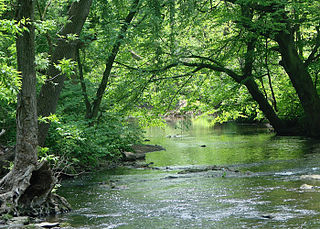
Haverford Township is a home rule municipality township in Delaware County, Pennsylvania, United States. Haverford is named after the town of Haverfordwest in Wales. It is a commuting suburb located due west of Philadelphia and is officially known as the Township of Haverford. Despite being under a home rule charter since 1977, it continues to operate under a Board of Commissioners divided into wards, as do "First Class" townships that are still under the Pennsylvania Township Code. Haverford Township was founded in 1682 and incorporated in 1911.

Rufus Matthew Jones was an American religious leader, writer, magazine editor, philosopher, and college professor. He was instrumental in the establishment of the Haverford Emergency Unit. One of the most influential Quakers of the 20th century, he was a Quaker historian and theologian as well as a philosopher. He is the only person to have delivered two Swarthmore Lectures.
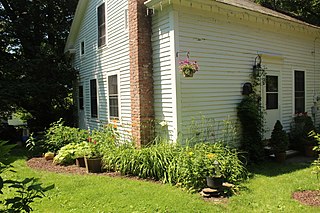
The Lemuel Haynes House is a historic house on County Road 27 in the village of South Granville, New York. Built in 1793, it was the home of Lemuel Haynes (1753-1833), the first African-American clergyman ordained in North America, from 1822 to 1833. It was designated a National Historic Landmark in 1975. The house was purchased from Charles Halderman as a private residence in 2009 by Bo Young and William J. Foote and is not normally open to the public.
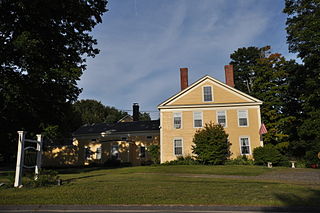
The Bagley-Bliss House is an historic house in Durham, Maine, United States. With a construction date traditionally given as 1772, this Greek Revival house is claimed to be the oldest in Durham, built by one of its early settlers, who also operated an inn on the premises. The house was listed on the National Register of Historic Places on March 22, 1996.
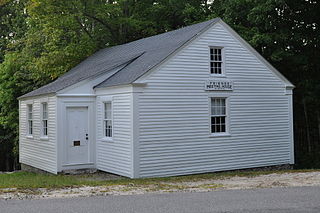
Friends Meetinghouse is a historic Quaker meeting house on Quaker Ridge Road in Casco, Maine. Built in 1814, it is the oldest surviving Quaker meeting house in the state. It was listed on the National Register of Historic Places in 1975.
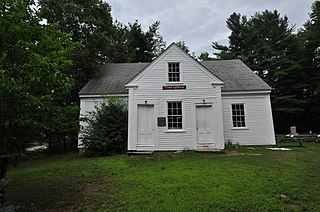
Pond Meeting House is a historic Quaker meeting house off United States Route 202 in China, Maine. Built in 1807, it is one of the oldest surviving buildings in the town, and an important element in the early life and spiritual growth of Quaker writer Rufus Jones. It was listed on the National Register of Historic Places in 1983.
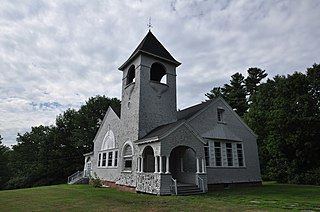
The Oak Grove Chapel, also known historically as the River Meetinghouse and the Sophia D. Bailey Chapel, is a non-denominational chapel at United States Route 201 and Oak Grove Road in Vassalboro, Maine. Built in 1786 as a Quaker meetinghouse, it was Vassalboro's first religious building. In 1895 it was restyled in the Shingle style, with a portico and tower added, and converted to non-denomination use by the Oak Grove-Coburn School. The building was listed on the National Register of Historic Places in 1977.

The South China Meeting House, now known as the South China Community Church, is a historic church on Village Street in South China, Maine. Built in 1884 as a Quaker meeting house, it is now home to multi-denominational congregation. It is notable as one of the places that influenced Quaker writer Rufus Jones, who was raised in South China and attended services here after this building replaced the Pond Meeting House. It was listed on the National Register of Historic Places in 1983.
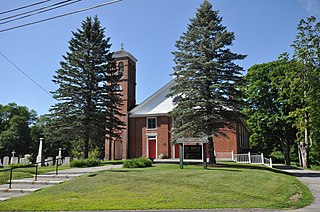
St. Denis Catholic Church is a historic Roman Catholic church at 298 Grand Army Road in North Whitefield, Maine. Built 1833–38, it is the third oldest Catholic church in New England. It was listed on the National Register of Historic Places in 1976. It remains in use as an active community of the Parish of St. Michael in the Diocese of Portland.

The East Village Meetinghouse, also known as the Old Brick Church, is a historic church at 55 Vermont Route 14 in East Montpelier, Vermont. Built in 1833-34, it is a fine local example of Greek Revival architecture, and has been the focal point of the historic East Village for most of its history. It was listed on the National Register of Historic Places in 1980.

Hall's Tavern, also once known as the Falmouth Tavern, and now the Quaker Tavern B&B and Inn, is an historic tavern at 377 Gray Road in Falmouth, Maine. Built about 1800 as a private home, it served for many years of the 19th century as a traveler accommodation, and is one of Falmouth's few surviving buildings of the period. It was listed on the National Register of Historic Places in 1978.

The Hatch House is an historic house at 2104 Sanford Road in Wells, Maine. Built about 1800, it is one of a collection of well-preserved 18th-century Cape style houses in Wells. It was listed on the National Register of Historic Places in 1979, listed as being in the North Berwick area. However, it is physically located in the town of Wells.
Mardock Mission was a historic meetinghouse built in 1898 in Mardock, Oklahoma. The mission was listed in the National Register of Historic Places in 1983 for its significance as the only remaining building associated with the Big Jim Band of Absentee Shawnee Indians, the Quaker Missionaries, and a pre-World War I socialist movement. The Absentee Shawnee were so named because in 1845 they had left the rest of the tribe in Kansas and settled along the Canadian River in Indian Territory. Big Jim, (Wapameepto), grandson of Tecumseh, was the chief of the Kispicotha, better known as the Absentee Shawnee. The group numbered 454 in 1904.

The Lewis Grout House is a historic house on Western Avenue at Bonnyvale Road in West Brattleboro, Vermont. Built in about 1880 for a widely traveled minister, it is a well-preserved and somewhat late example of Gothic Revival architecture. It was listed on the National Register of Historic Places in 1996.

The Days Ferry Historic District encompasses a rural village that grew around a ferry crossing on the Kennebec River in what is now Woolwich, Maine. The village and ferry were on the main stage route between Bath and Wiscasset until the 1870s, and retains a concentration of well-preserved 18th and early 19th-century houses. The district was listed on the National Register of Historic Places in 1975.

The Joseph and Hannah Maxcy Homestead is a historic house at 630 South Union Road in South Union, Maine. Built in 1802 by Ebenezer Alden, a regionally well-known housewright, it is one of the finest period examples of Federal architecture, with high-quality interior woodwork. It was listed on the National Register of Historic Places in 2004.

The Abel Jones House is a historic house at 33 Jones Road in the village of South China, Maine. Built in 1815, it is a fine local example of Federal period architecture, which is most notable as the birthplace and childhood home of the important Quaker writer and historian Rufus Jones. The house was listed on the National Register of Historic Places in 1983; it is one of several properties in South China to be listed for their association with Jones.

Pendle Hill is a historic summer house between United States Route 202 and China Lake in South China, Maine. Built in 1916, it served as the summer home of Quaker theologian, historian, and writer Rufus Jones until his death in 1948. The property was listed on the National Register of Historic Places in 1983.

Eli Jones (1807–1890) was an American Quaker preacher.

Sybil Jones (1808–1873) was an American Quaker preacher and missionary.





















